Parabola

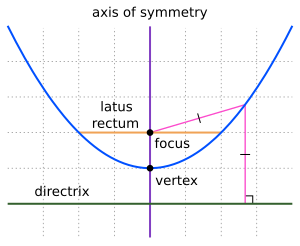

In mathematics, a parabola is a plane curve which is mirror-symmetrical and is approximately U-shaped. It fits several superficially different mathematical descriptions, which can all be proved to define exactly the same curves.
One description of a parabola involves a point (the focus) and a line (the directrix). The focus does not lie on the directrix. The parabola is the locus of points in that plane that are equidistant from the directrix and the focus. Another description of a parabola is as a conic section, created from the intersection of a right circular conical surface and a plane parallel to another plane that is tangential to the conical surface.[a]
The graph of a quadratic function (with ) is a parabola with its axis parallel to the y-axis. Conversely, every such parabola is the graph of a quadratic function.
The line perpendicular to the directrix and passing through the focus (that is, the line that splits the parabola through the middle) is called the "axis of symmetry". The point where the parabola intersects its axis of symmetry is called the "vertex" and is the point where the parabola is most sharply curved. The distance between the vertex and the focus, measured along the axis of symmetry, is the "focal length". The "latus rectum" is the chord of the parabola that is parallel to the directrix and passes through the focus. Parabolas can open up, down, left, right, or in some other arbitrary direction. Any parabola can be repositioned and rescaled to fit exactly on any other parabola—that is, all parabolas are geometrically similar.
Parabolas have the property that, if they are made of material that reflects light, then light that travels parallel to the axis of symmetry of a parabola and strikes its concave side is reflected to its focus, regardless of where on the parabola the reflection occurs. Conversely, light that originates from a point source at the focus is reflected into a parallel ("collimated") beam, leaving the parabola parallel to the axis of symmetry. The same effects occur with sound and other waves. This reflective property is the basis of many practical uses of parabolas.
The parabola has many important applications, from a parabolic antenna or parabolic microphone to automobile headlight reflectors and the design of ballistic missiles. It is frequently used in physics, engineering, and many other areas.
History
[edit]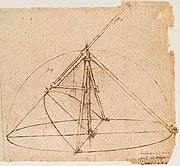
The earliest known work on conic sections was by Menaechmus in the 4th century BC. He discovered a way to solve the problem of doubling the cube using parabolas. (The solution, however, does not meet the requirements of compass-and-straightedge construction.) The area enclosed by a parabola and a line segment, the so-called "parabola segment", was computed by Archimedes by the method of exhaustion in the 3rd century BC, in his The Quadrature of the Parabola. The name "parabola" is due to Apollonius, who discovered many properties of conic sections. It means "application", referring to "application of areas" concept, that has a connection with this curve, as Apollonius had proved.[1] The focus–directrix property of the parabola and other conic sections is due to Pappus.
Galileo showed that the path of a projectile follows a parabola, a consequence of uniform acceleration due to gravity.
The idea that a parabolic reflector could produce an image was already well known before the invention of the reflecting telescope.[2] Designs were proposed in the early to mid-17th century by many mathematicians, including René Descartes, Marin Mersenne,[3] and James Gregory.[4] When Isaac Newton built the first reflecting telescope in 1668, he skipped using a parabolic mirror because of the difficulty of fabrication, opting for a spherical mirror. Parabolic mirrors are used in most modern reflecting telescopes and in satellite dishes and radar receivers.[5]
Definition as a locus of points
[edit]A parabola can be defined geometrically as a set of points (locus of points) in the Euclidean plane:
The midpoint of the perpendicular from the focus onto the directrix is called the vertex, and the line is the axis of symmetry of the parabola.
In a Cartesian coordinate system
[edit]Axis of symmetry parallel to the y axis
[edit]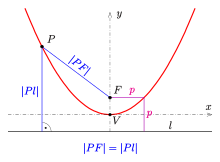
If one introduces Cartesian coordinates, such that and the directrix has the equation , one obtains for a point from the equation . Solving for yields
This parabola is U-shaped (opening to the top).
The horizontal chord through the focus (see picture in opening section) is called the latus rectum; one half of it is the semi-latus rectum. The latus rectum is parallel to the directrix. The semi-latus rectum is designated by the letter . From the picture one obtains
The latus rectum is defined similarly for the other two conics – the ellipse and the hyperbola. The latus rectum is the line drawn through a focus of a conic section parallel to the directrix and terminated both ways by the curve. For any case, is the radius of the osculating circle at the vertex. For a parabola, the semi-latus rectum, , is the distance of the focus from the directrix. Using the parameter , the equation of the parabola can be rewritten as
More generally, if the vertex is , the focus , and the directrix , one obtains the equation
Remarks:
- In the case of the parabola has a downward opening.
- The presumption that the axis is parallel to the y axis allows one to consider a parabola as the graph of a polynomial of degree 2, and conversely: the graph of an arbitrary polynomial of degree 2 is a parabola (see next section).
- If one exchanges and , one obtains equations of the form . These parabolas open to the left (if ) or to the right (if ).
General position
[edit]
If the focus is , and the directrix , then one obtains the equation
(the left side of the equation uses the Hesse normal form of a line to calculate the distance ).
For a parametric equation of a parabola in general position see § As the affine image of the unit parabola.
The implicit equation of a parabola is defined by an irreducible polynomial of degree two: such that or, equivalently, such that is the square of a linear polynomial.
As a graph of a function
[edit]
The previous section shows that any parabola with the origin as vertex and the y axis as axis of symmetry can be considered as the graph of a function
For the parabolas are opening to the top, and for are opening to the bottom (see picture). From the section above one obtains:
- The focus is ,
- the focal length , the semi-latus rectum is ,
- the vertex is ,
- the directrix has the equation ,
- the tangent at point has the equation .
For the parabola is the unit parabola with equation . Its focus is , the semi-latus rectum , and the directrix has the equation .
The general function of degree 2 is Completing the square yields which is the equation of a parabola with
- the axis (parallel to the y axis),
- the focal length , the semi-latus rectum ,
- the vertex ,
- the focus ,
- the directrix ,
- the point of the parabola intersecting the y axis has coordinates ,
- the tangent at a point on the y axis has the equation .
Similarity to the unit parabola
[edit]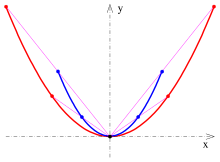
Two objects in the Euclidean plane are similar if one can be transformed to the other by a similarity, that is, an arbitrary composition of rigid motions (translations and rotations) and uniform scalings.
A parabola with vertex can be transformed by the translation to one with the origin as vertex. A suitable rotation around the origin can then transform the parabola to one that has the y axis as axis of symmetry. Hence the parabola can be transformed by a rigid motion to a parabola with an equation . Such a parabola can then be transformed by the uniform scaling into the unit parabola with equation . Thus, any parabola can be mapped to the unit parabola by a similarity.[6]
A synthetic approach, using similar triangles, can also be used to establish this result.[7]
The general result is that two conic sections (necessarily of the same type) are similar if and only if they have the same eccentricity.[6] Therefore, only circles (all having eccentricity 0) share this property with parabolas (all having eccentricity 1), while general ellipses and hyperbolas do not.
There are other simple affine transformations that map the parabola onto the unit parabola, such as . But this mapping is not a similarity, and only shows that all parabolas are affinely equivalent (see § As the affine image of the unit parabola).
As a special conic section
[edit]
The pencil of conic sections with the x axis as axis of symmetry, one vertex at the origin (0, 0) and the same semi-latus rectum can be represented by the equation with the eccentricity.
- For the conic is a circle (osculating circle of the pencil),
- for an ellipse,
- for the parabola with equation
- for a hyperbola (see picture).
In polar coordinates
[edit]
If p > 0, the parabola with equation (opening to the right) has the polar representation where .
Its vertex is , and its focus is .
If one shifts the origin into the focus, that is, , one obtains the equation
Remark 1: Inverting this polar form shows that a parabola is the inverse of a cardioid.
Remark 2: The second polar form is a special case of a pencil of conics with focus (see picture): ( is the eccentricity).
Conic section and quadratic form
[edit]Diagram, description, and definitions
[edit]
The diagram represents a cone with its axis AV. The point A is its apex. An inclined cross-section of the cone, shown in pink, is inclined from the axis by the same angle θ, as the side of the cone. According to the definition of a parabola as a conic section, the boundary of this pink cross-section EPD is a parabola.
A cross-section perpendicular to the axis of the cone passes through the vertex P of the parabola. This cross-section is circular, but appears elliptical when viewed obliquely, as is shown in the diagram. Its centre is V, and PK is a diameter. We will call its radius r.
Another perpendicular to the axis, circular cross-section of the cone is farther from the apex A than the one just described. It has a chord DE, which joins the points where the parabola intersects the circle. Another chord BC is the perpendicular bisector of DE and is consequently a diameter of the circle. These two chords and the parabola's axis of symmetry PM all intersect at the point M.
All the labelled points, except D and E, are coplanar. They are in the plane of symmetry of the whole figure. This includes the point F, which is not mentioned above. It is defined and discussed below, in § Position of the focus.
Let us call the length of DM and of EM x, and the length of PM y.
Derivation of quadratic equation
[edit]The lengths of BM and CM are:
- (triangle BPM is isosceles, because
- (PMCK is a parallelogram).
Using the intersecting chords theorem on the chords BC and DE, we get
Substituting:
Rearranging:
For any given cone and parabola, r and θ are constants, but x and y are variables that depend on the arbitrary height at which the horizontal cross-section BECD is made. This last equation shows the relationship between these variables. They can be interpreted as Cartesian coordinates of the points D and E, in a system in the pink plane with P as its origin. Since x is squared in the equation, the fact that D and E are on opposite sides of the y axis is unimportant. If the horizontal cross-section moves up or down, toward or away from the apex of the cone, D and E move along the parabola, always maintaining the relationship between x and y shown in the equation. The parabolic curve is therefore the locus of points where the equation is satisfied, which makes it a Cartesian graph of the quadratic function in the equation.
Focal length
[edit]It is proved in a preceding section that if a parabola has its vertex at the origin, and if it opens in the positive y direction, then its equation is y = x2/4f, where f is its focal length.[b] Comparing this with the last equation above shows that the focal length of the parabola in the cone is r sin θ.
Position of the focus
[edit]In the diagram above, the point V is the foot of the perpendicular from the vertex of the parabola to the axis of the cone. The point F is the foot of the perpendicular from the point V to the plane of the parabola.[c] By symmetry, F is on the axis of symmetry of the parabola. Angle VPF is complementary to θ, and angle PVF is complementary to angle VPF, therefore angle PVF is θ. Since the length of PV is r, the distance of F from the vertex of the parabola is r sin θ. It is shown above that this distance equals the focal length of the parabola, which is the distance from the vertex to the focus. The focus and the point F are therefore equally distant from the vertex, along the same line, which implies that they are the same point. Therefore, the point F, defined above, is the focus of the parabola.
This discussion started from the definition of a parabola as a conic section, but it has now led to a description as a graph of a quadratic function. This shows that these two descriptions are equivalent. They both define curves of exactly the same shape.
Alternative proof with Dandelin spheres
[edit]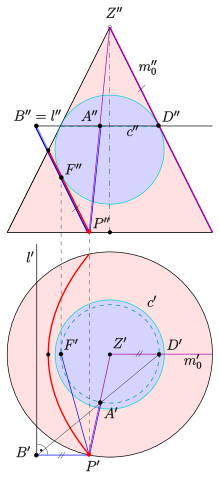
An alternative proof can be done using Dandelin spheres. It works without calculation and uses elementary geometric considerations only (see the derivation below).
The intersection of an upright cone by a plane , whose inclination from vertical is the same as a generatrix (a.k.a. generator line, a line containing the apex and a point on the cone surface) of the cone, is a parabola (red curve in the diagram).
This generatrix is the only generatrix of the cone that is parallel to plane . Otherwise, if there are two generatrices parallel to the intersecting plane, the intersection curve will be a hyperbola (or degenerate hyperbola, if the two generatrices are in the intersecting plane). If there is no generatrix parallel to the intersecting plane, the intersection curve will be an ellipse or a circle (or a point).
Let plane be the plane that contains the vertical axis of the cone and line . The inclination of plane from vertical is the same as line means that, viewing from the side (that is, the plane is perpendicular to plane ), .
In order to prove the directrix property of a parabola (see § Definition as a locus of points above), one uses a Dandelin sphere , which is a sphere that touches the cone along a circle and plane at point . The plane containing the circle intersects with plane at line . There is a mirror symmetry in the system consisting of plane , Dandelin sphere and the cone (the plane of symmetry is ).
Since the plane containing the circle is perpendicular to plane , and , their intersection line must also be perpendicular to plane . Since line is in plane , .
It turns out that is the focus of the parabola, and is the directrix of the parabola.
- Let be an arbitrary point of the intersection curve.
- The generatrix of the cone containing intersects circle at point .
- The line segments and are tangential to the sphere , and hence are of equal length.
- Generatrix intersects the circle at point . The line segments and are tangential to the sphere , and hence are of equal length.
- Let line be the line parallel to and passing through point . Since , and point is in plane , line must be in plane . Since , we know that as well.
- Let point be the foot of the perpendicular from point to line , that is, is a segment of line , and hence .
- From intercept theorem and we know that . Since , we know that , which means that the distance from to the focus is equal to the distance from to the directrix .
Proof of the reflective property
[edit]
The reflective property states that if a parabola can reflect light, then light that enters it travelling parallel to the axis of symmetry is reflected toward the focus. This is derived from geometrical optics, based on the assumption that light travels in rays.
Consider the parabola y = x2. Since all parabolas are similar, this simple case represents all others.
Construction and definitions
[edit]The point E is an arbitrary point on the parabola. The focus is F, the vertex is A (the origin), and the line FA is the axis of symmetry. The line EC is parallel to the axis of symmetry, intersects the x axis at D and intersects the directrix at C. The point B is the midpoint of the line segment FC.
Deductions
[edit]The vertex A is equidistant from the focus F and from the directrix. Since C is on the directrix, the y coordinates of F and C are equal in absolute value and opposite in sign. B is the midpoint of FC. Its x coordinate is half that of D, that is, x/2. The slope of the line BE is the quotient of the lengths of ED and BD, which is x2/x/2 = 2x. But 2x is also the slope (first derivative) of the parabola at E. Therefore, the line BE is the tangent to the parabola at E.
The distances EF and EC are equal because E is on the parabola, F is the focus and C is on the directrix. Therefore, since B is the midpoint of FC, triangles △FEB and △CEB are congruent (three sides), which implies that the angles marked α are congruent. (The angle above E is vertically opposite angle ∠BEC.) This means that a ray of light that enters the parabola and arrives at E travelling parallel to the axis of symmetry will be reflected by the line BE so it travels along the line EF, as shown in red in the diagram (assuming that the lines can somehow reflect light). Since BE is the tangent to the parabola at E, the same reflection will be done by an infinitesimal arc of the parabola at E. Therefore, light that enters the parabola and arrives at E travelling parallel to the axis of symmetry of the parabola is reflected by the parabola toward its focus.
This conclusion about reflected light applies to all points on the parabola, as is shown on the left side of the diagram. This is the reflective property.
Other consequences
[edit]There are other theorems that can be deduced simply from the above argument.
Tangent bisection property
[edit]The above proof and the accompanying diagram show that the tangent BE bisects the angle ∠FEC. In other words, the tangent to the parabola at any point bisects the angle between the lines joining the point to the focus and perpendicularly to the directrix.
Intersection of a tangent and perpendicular from focus
[edit]
Since triangles △FBE and △CBE are congruent, FB is perpendicular to the tangent BE. Since B is on the x axis, which is the tangent to the parabola at its vertex, it follows that the point of intersection between any tangent to a parabola and the perpendicular from the focus to that tangent lies on the line that is tangential to the parabola at its vertex. See animated diagram[8] and pedal curve.
Reflection of light striking the convex side
[edit]If light travels along the line CE, it moves parallel to the axis of symmetry and strikes the convex side of the parabola at E. It is clear from the above diagram that this light will be reflected directly away from the focus, along an extension of the segment FE.
Alternative proofs
[edit]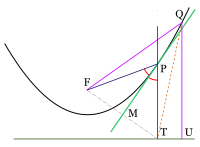
The above proofs of the reflective and tangent bisection properties use a line of calculus. Here a geometric proof is presented.
In this diagram, F is the focus of the parabola, and T and U lie on its directrix. P is an arbitrary point on the parabola. PT is perpendicular to the directrix, and the line MP bisects angle ∠FPT. Q is another point on the parabola, with QU perpendicular to the directrix. We know that FP = PT and FQ = QU. Clearly, QT > QU, so QT > FQ. All points on the bisector MP are equidistant from F and T, but Q is closer to F than to T. This means that Q is to the left of MP, that is, on the same side of it as the focus. The same would be true if Q were located anywhere else on the parabola (except at the point P), so the entire parabola, except the point P, is on the focus side of MP. Therefore, MP is the tangent to the parabola at P. Since it bisects the angle ∠FPT, this proves the tangent bisection property.
The logic of the last paragraph can be applied to modify the above proof of the reflective property. It effectively proves the line BE to be the tangent to the parabola at E if the angles α are equal. The reflective property follows as shown previously.
Pin and string construction
[edit]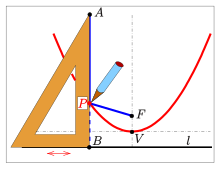
The definition of a parabola by its focus and directrix can be used for drawing it with help of pins and strings:[9]
- Choose the focus and the directrix of the parabola.
- Take a triangle of a set square and prepare a string with length (see diagram).
- Pin one end of the string at point of the triangle and the other one to the focus .
- Position the triangle such that the second edge of the right angle is free to slide along the directrix.
- Take a pen and hold the string tight to the triangle.
- While moving the triangle along the directrix, the pen draws an arc of a parabola, because of (see definition of a parabola).
Properties related to Pascal's theorem
[edit]A parabola can be considered as the affine part of a non-degenerated projective conic with a point on the line of infinity , which is the tangent at . The 5-, 4- and 3- point degenerations of Pascal's theorem are properties of a conic dealing with at least one tangent. If one considers this tangent as the line at infinity and its point of contact as the point at infinity of the y axis, one obtains three statements for a parabola.
The following properties of a parabola deal only with terms connect, intersect, parallel, which are invariants of similarities. So, it is sufficient to prove any property for the unit parabola with equation .
4-points property
[edit]
Any parabola can be described in a suitable coordinate system by an equation .
Proof: straightforward calculation for the unit parabola .
Application: The 4-points property of a parabola can be used for the construction of point , while and are given.
Remark: the 4-points property of a parabola is an affine version of the 5-point degeneration of Pascal's theorem.
3-points–1-tangent property
[edit]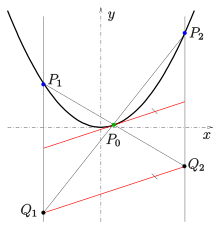
Let be three points of the parabola with equation and the intersection of the secant line with the line and the intersection of the secant line with the line (see picture). Then the tangent at point is parallel to the line . (The lines and are parallel to the axis of the parabola.)
Proof: can be performed for the unit parabola . A short calculation shows: line has slope which is the slope of the tangent at point .
Application: The 3-points-1-tangent-property of a parabola can be used for the construction of the tangent at point , while are given.
Remark: The 3-points-1-tangent-property of a parabola is an affine version of the 4-point-degeneration of Pascal's theorem.
2-points–2-tangents property
[edit]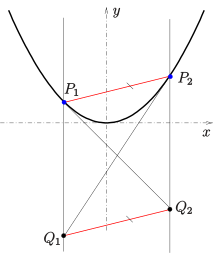
Let be two points of the parabola with equation , and the intersection of the tangent at point with the line , and the intersection of the tangent at point with the line (see picture). Then the secant is parallel to the line . (The lines and are parallel to the axis of the parabola.)
Proof: straight forward calculation for the unit parabola .
Application: The 2-points–2-tangents property can be used for the construction of the tangent of a parabola at point , if and the tangent at are given.
Remark 1: The 2-points–2-tangents property of a parabola is an affine version of the 3-point degeneration of Pascal's theorem.
Remark 2: The 2-points–2-tangents property should not be confused with the following property of a parabola, which also deals with 2 points and 2 tangents, but is not related to Pascal's theorem.
Axis direction
[edit]
The statements above presume the knowledge of the axis direction of the parabola, in order to construct the points . The following property determines the points by two given points and their tangents only, and the result is that the line is parallel to the axis of the parabola.
Let
- be two points of the parabola , and be their tangents;
- be the intersection of the tangents ,
- be the intersection of the parallel line to through with the parallel line to through (see picture).
Then the line is parallel to the axis of the parabola and has the equation
Proof: can be done (like the properties above) for the unit parabola .
Application: This property can be used to determine the direction of the axis of a parabola, if two points and their tangents are given. An alternative way is to determine the midpoints of two parallel chords, see section on parallel chords.
Remark: This property is an affine version of the theorem of two perspective triangles of a non-degenerate conic.[10]
Steiner generation
[edit]Parabola
[edit]
Steiner established the following procedure for the construction of a non-degenerate conic (see Steiner conic):
This procedure can be used for a simple construction of points on the parabola :
- Consider the pencil at the vertex and the set of lines that are parallel to the y axis.
- Let be a point on the parabola, and , .
- The line segment is divided into n equally spaced segments, and this division is projected (in the direction ) onto the line segment (see figure). This projection gives rise to a projective mapping from pencil onto the pencil .
- The intersection of the line and the i-th parallel to the y axis is a point on the parabola.
Proof: straightforward calculation.
Remark: Steiner's generation is also available for ellipses and hyperbolas.
Dual parabola
[edit]
A dual parabola consists of the set of tangents of an ordinary parabola.
The Steiner generation of a conic can be applied to the generation of a dual conic by changing the meanings of points and lines:
In order to generate elements of a dual parabola, one starts with
- three points not on a line,
- divides the line sections and each into equally spaced line segments and adds numbers as shown in the picture.
- Then the lines are tangents of a parabola, hence elements of a dual parabola.
- The parabola is a Bezier curve of degree 2 with the control points .
The proof is a consequence of the de Casteljau algorithm for a Bezier curve of degree 2.
Inscribed angles and the 3-point form
[edit]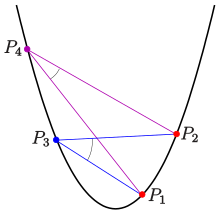
A parabola with equation is uniquely determined by three points with different x coordinates. The usual procedure to determine the coefficients is to insert the point coordinates into the equation. The result is a linear system of three equations, which can be solved by Gaussian elimination or Cramer's rule, for example. An alternative way uses the inscribed angle theorem for parabolas.
In the following, the angle of two lines will be measured by the difference of the slopes of the line with respect to the directrix of the parabola. That is, for a parabola of equation the angle between two lines of equations is measured by
Analogous to the inscribed angle theorem for circles, one has the inscribed angle theorem for parabolas:[11][12]
(Proof: straightforward calculation: If the points are on a parabola, one may translate the coordinates for having the equation , then one has if the points are on the parabola.)
A consequence is that the equation (in ) of the parabola determined by 3 points with different x coordinates is (if two x coordinates are equal, there is no parabola with directrix parallel to the x axis, which passes through the points) Multiplying by the denominators that depend on one obtains the more standard form
Pole–polar relation
[edit]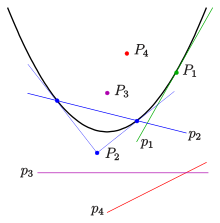
In a suitable coordinate system any parabola can be described by an equation . The equation of the tangent at a point is One obtains the function on the set of points of the parabola onto the set of tangents.
Obviously, this function can be extended onto the set of all points of to a bijection between the points of and the lines with equations . The inverse mapping is This relation is called the pole–polar relation of the parabola, where the point is the pole, and the corresponding line its polar.
By calculation, one checks the following properties of the pole–polar relation of the parabola:
- For a point (pole) on the parabola, the polar is the tangent at this point (see picture: ).
- For a pole outside the parabola the intersection points of its polar with the parabola are the touching points of the two tangents passing (see picture: ).
- For a point within the parabola the polar has no point with the parabola in common (see picture: and ).
- The intersection point of two polar lines (for example, ) is the pole of the connecting line of their poles (in example: ).
- Focus and directrix of the parabola are a pole–polar pair.
Remark: Pole–polar relations also exist for ellipses and hyperbolas.
Tangent properties
[edit]Two tangent properties related to the latus rectum
[edit]Let the line of symmetry intersect the parabola at point Q, and denote the focus as point F and its distance from point Q as f. Let the perpendicular to the line of symmetry, through the focus, intersect the parabola at a point T. Then (1) the distance from F to T is 2f, and (2) a tangent to the parabola at point T intersects the line of symmetry at a 45° angle.[13]: 26

Orthoptic property
[edit]If two tangents to a parabola are perpendicular to each other, then they intersect on the directrix. Conversely, two tangents that intersect on the directrix are perpendicular. In other words, at any point on the directrix the whole parabola subtends a right angle.
Lambert's theorem
[edit]Let three tangents to a parabola form a triangle. Then Lambert's theorem states that the focus of the parabola lies on the circumcircle of the triangle.[14][8]: Corollary 20
Tsukerman's converse to Lambert's theorem states that, given three lines that bound a triangle, if two of the lines are tangent to a parabola whose focus lies on the circumcircle of the triangle, then the third line is also tangent to the parabola.[15]
Facts related to chords and arcs
[edit]Focal length calculated from parameters of a chord
[edit]Suppose a chord crosses a parabola perpendicular to its axis of symmetry. Let the length of the chord between the points where it intersects the parabola be c and the distance from the vertex of the parabola to the chord, measured along the axis of symmetry, be d. The focal length, f, of the parabola is given by
Suppose a system of Cartesian coordinates is used such that the vertex of the parabola is at the origin, and the axis of symmetry is the y axis. The parabola opens upward. It is shown elsewhere in this article that the equation of the parabola is 4fy = x2, where f is the focal length. At the positive x end of the chord, x = c/2 and y = d. Since this point is on the parabola, these coordinates must satisfy the equation above. Therefore, by substitution, . From this, .
Area enclosed between a parabola and a chord
[edit]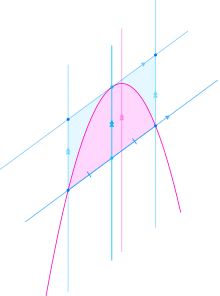
The area enclosed between a parabola and a chord (see diagram) is two-thirds of the area of a parallelogram that surrounds it. One side of the parallelogram is the chord, and the opposite side is a tangent to the parabola.[16][17] The slope of the other parallel sides is irrelevant to the area. Often, as here, they are drawn parallel with the parabola's axis of symmetry, but this is arbitrary.
A theorem equivalent to this one, but different in details, was derived by Archimedes in the 3rd century BCE. He used the areas of triangles, rather than that of the parallelogram.[d] See The Quadrature of the Parabola.
If the chord has length b and is perpendicular to the parabola's axis of symmetry, and if the perpendicular distance from the parabola's vertex to the chord is h, the parallelogram is a rectangle, with sides of b and h. The area A of the parabolic segment enclosed by the parabola and the chord is therefore
This formula can be compared with the area of a triangle: 1/2bh.
In general, the enclosed area can be calculated as follows. First, locate the point on the parabola where its slope equals that of the chord. This can be done with calculus, or by using a line that is parallel to the axis of symmetry of the parabola and passes through the midpoint of the chord. The required point is where this line intersects the parabola.[e] Then, using the formula given in Distance from a point to a line, calculate the perpendicular distance from this point to the chord. Multiply this by the length of the chord to get the area of the parallelogram, then by 2/3 to get the required enclosed area.
Corollary concerning midpoints and endpoints of chords
[edit]
A corollary of the above discussion is that if a parabola has several parallel chords, their midpoints all lie on a line parallel to the axis of symmetry. If tangents to the parabola are drawn through the endpoints of any of these chords, the two tangents intersect on this same line parallel to the axis of symmetry (see Axis-direction of a parabola).[f]
Arc length
[edit]If a point X is located on a parabola with focal length f, and if p is the perpendicular distance from X to the axis of symmetry of the parabola, then the lengths of arcs of the parabola that terminate at X can be calculated from f and p as follows, assuming they are all expressed in the same units.[g]
This quantity s is the length of the arc between X and the vertex of the parabola.
The length of the arc between X and the symmetrically opposite point on the other side of the parabola is 2s.
The perpendicular distance p can be given a positive or negative sign to indicate on which side of the axis of symmetry X is situated. Reversing the sign of p reverses the signs of h and s without changing their absolute values. If these quantities are signed, the length of the arc between any two points on the parabola is always shown by the difference between their values of s. The calculation can be simplified by using the properties of logarithms:
This can be useful, for example, in calculating the size of the material needed to make a parabolic reflector or parabolic trough.
This calculation can be used for a parabola in any orientation. It is not restricted to the situation where the axis of symmetry is parallel to the y axis.
A geometrical construction to find a sector area
[edit]S is the focus, and V is the principal vertex of the parabola VG. Draw VX perpendicular to SV.
Take any point B on VG and drop a perpendicular BQ from B to VX. Draw perpendicular ST intersecting BQ, extended if necessary, at T. At B draw the perpendicular BJ, intersecting VX at J.
For the parabola, the segment VBV, the area enclosed by the chord VB and the arc VB, is equal to ∆VBQ / 3, also .
The area of the parabolic sector .
Since triangles TSB and QBJ are similar,
Therefore, the area of the parabolic sector and can be found from the length of VJ, as found above.
A circle through S, V and B also passes through J.
Conversely, if a point, B on the parabola VG is to be found so that the area of the sector SVB is equal to a specified value, determine the point J on VX and construct a circle through S, V and J. Since SJ is the diameter, the center of the circle is at its midpoint, and it lies on the perpendicular bisector of SV, a distance of one half VJ from SV. The required point B is where this circle intersects the parabola.
If a body traces the path of the parabola due to an inverse square force directed towards S, the area SVB increases at a constant rate as point B moves forward. It follows that J moves at constant speed along VX as B moves along the parabola.
If the speed of the body at the vertex where it is moving perpendicularly to SV is v, then the speed of J is equal to 3v/4.
The construction can be extended simply to include the case where neither radius coincides with the axis SV as follows. Let A be a fixed point on VG between V and B, and point H be the intersection on VX with the perpendicular to SA at A. From the above, the area of the parabolic sector .
Conversely, if it is required to find the point B for a particular area SAB, find point J from HJ and point B as before. By Book 1, Proposition 16, Corollary 6 of Newton's Principia, the speed of a body moving along a parabola with a force directed towards the focus is inversely proportional to the square root of the radius. If the speed at A is v, then at the vertex V it is , and point J moves at a constant speed of .
The above construction was devised by Isaac Newton and can be found in Book 1 of Philosophiæ Naturalis Principia Mathematica as Proposition 30.
Focal length and radius of curvature at the vertex
[edit]The focal length of a parabola is half of its radius of curvature at its vertex.
- Proof
- Image is inverted. AB is x axis. C is origin. O is center. A is (x, y). OA = OC = R. PA = x. CP = y. OP = (R − y). Other points and lines are irrelevant for this purpose.
- The radius of curvature at the vertex is twice the focal length. The measurements shown on the above diagram are in units of the latus rectum, which is four times the focal length.
Consider a point (x, y) on a circle of radius R and with center at the point (0, R). The circle passes through the origin. If the point is near the origin, the Pythagorean theorem shows that
But if (x, y) is extremely close to the origin, since the x axis is a tangent to the circle, y is very small compared with x, so y2 is negligible compared with the other terms. Therefore, extremely close to the origin
| (1) |
Compare this with the parabola
| (2) |
which has its vertex at the origin, opens upward, and has focal length f (see preceding sections of this article).
Equations (1) and (2) are equivalent if R = 2f. Therefore, this is the condition for the circle and parabola to coincide at and extremely close to the origin. The radius of curvature at the origin, which is the vertex of the parabola, is twice the focal length.
- Corollary
A concave mirror that is a small segment of a sphere behaves approximately like a parabolic mirror, focusing parallel light to a point midway between the centre and the surface of the sphere.
As the affine image of the unit parabola
[edit]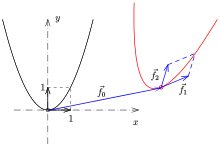
Another definition of a parabola uses affine transformations:
Parametric representation
[edit]An affine transformation of the Euclidean plane has the form , where is a regular matrix (determinant is not 0), and is an arbitrary vector. If are the column vectors of the matrix , the unit parabola is mapped onto the parabola where
- is a point of the parabola,
- is a tangent vector at point ,
- is parallel to the axis of the parabola (axis of symmetry through the vertex).
Vertex
[edit]In general, the two vectors are not perpendicular, and is not the vertex, unless the affine transformation is a similarity.
The tangent vector at the point is . At the vertex the tangent vector is orthogonal to . Hence the parameter of the vertex is the solution of the equation which is and the vertex is
Focal length and focus
[edit]The focal length can be determined by a suitable parameter transformation (which does not change the geometric shape of the parabola). The focal length is Hence the focus of the parabola is









































































![{\displaystyle r=2p{\frac {\cos \varphi }{\sin ^{2}\varphi }},\quad \varphi \in \left[-{\tfrac {\pi }{2}},{\tfrac {\pi }{2}}\right]\setminus \{0\}}](https://wikimedia.org/api/rest_v1/media/math/render/svg/82721d5980ef626bae2f7ff613c61183587f53b0)







































































































































![{\displaystyle {\begin{aligned}x^{2}+(R-y)^{2}&=R^{2},\\[1ex]x^{2}+R^{2}-2Ry+y^{2}&=R^{2},\\[1ex]x^{2}+y^{2}&=2Ry.\end{aligned}}}](https://wikimedia.org/api/rest_v1/media/math/render/svg/96f2f758225e42f0814f6e4be6d7f6b717ae3a86)















